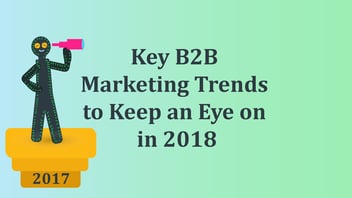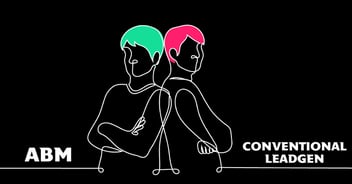
Ageism in B2B Tech Marketing?
Since the beginning of time, thought leaders have proclaimed that technology is transforming marketing forever, just like it has done for so many other professions. B2B tech marketing especially is seen as a fast-paced, ever-changing field where you have to keep up or get left behind. While all this is true, I am adamant that much and little has changed in the world of marketing… and marketers. And this stagnation is what makes the older marketers still relevant. This is why.
Tech didn’t kill classic marketing
In my experience, while the tools and tactics may have changed with the tides, the fundamentals have stayed the same. There are no shortcuts; a marketer still needs to define the target audience, understand the real USP, craft a very simple and sharp message that speaks to the crowd and ensure that the brand promise delivers on customer satisfaction. In short, despite all the hype, technology hasn’t created a way to bypass the hard strategic work that the 7 Ps of marketing demand.
The number one feedback I receive from younger employees is the disconnect between what they learned from their college education and the skills that marketing campaigns they are working on require. The crux of the problem is that new marketers are all too often taught only the marketing tools and tactics and are skipping over the classical marketing fundamentals. It’s a serious complaint that’s created a knowledge gap in the industry that is very difficult to bridge
It is also undoubtedly why the tech companies and VCs that I work with on a daily basis are on a continual hunt for the more mature “full stack” marketer to run their marketing team. Interestingly, age discrimination here is more prevalent toward the younger folks as opposed to the older.
Unchanged in tech marketing
The following marketing pillars are as relevant today as they were 20+ years ago.
Human factors
Experience vs. fresh blood
Popular opinion has it that marketing is a young person’s game and that older marketers have nothing to offer. But that’s far from the truth. Marketing is still a career for people of all ages.
A recent survey conducted by Korn Ferry on 1000 leading US companies concluded that the average age of a CMO in the tech industry is 53. Tom Goodwin, is also loud and proud about the need for older marketers in the business; older folks who, “understand real clients' issues, and who above all else, can see the changes in business and marketing in the context of decades of what has happened before.”
There is no questioning the digital divide between the old(er) guard who paid homage to libraries and the younger generation that grew up with Google at their fingertips. But like most things in life, work and marketing, it’s all about balance and how the old and new work together to their mutual advantage.
Knowing your ecosystems
Ecosystems have always been critical to company marketing and its business survival. Whether offline or online - networking, ensuring you are active and up to speed on what’s going on in the ecosystem is critical to success. Your ecosystem may have transitioned somewhat online to LinkedIn, Reddit, and Facebook (the list goes on), but it’s still fulfilling the same role as professional associations, trade forums and conferences.
The sales-marketing divide
One of my all time debate favorites has not changed. For all the love of political correctness and common understanding, I maintain that the divide (and friction) between sales and marketing is as strong as ever. Sales teams and marketers still argue about the same issues:
-
Lead generation and what constitutes an MQL and SQL
-
Marketing budgets and how they should be spent
-
Who updated, or didn’t update the CRM
-
Reporting, or lack thereof
-
“Flexible” pricing to close deals
And there’s more where these gems come from.
Obligatory factors
Product launches
As I mention earlier, meticulous planning and following the fundamentals of the faithful 7Ps will for eternity be the anchor for any product launch. Defining the product and the pain point it solves, where it will be placed and purchased, at what price and how it will be promoted demand a deep understanding of the market and its rules of engagement. Mistakes in these steps of strategic planning will lead to delays in leads and sales, if not worse.
Technology has added channels like social media, bloggers and influencers to the mix, but it hasn’t taken away the need for strategic groundwork. The most prominent change over the years is the time to market which has been sliced immeasurably and is the cause of marketers’ anxiety.
Outsmarting the competition
Technology has perhaps amplified the number of players and often reduced the barrier to entry into a certain ecosystem but the rules of engagement remain unscathed. Marketers still need to shout louder than their rivals, sharpen the messaging and outsmart the competition in order to gain traction and lead.
Trade shows
Much as I wish that trade shows would vanish into thin air, the internet hasn’t killed them. Decision makers from every sector still travel thousands of kilometers, sleep in grand or flea ridden hotels, pay hundreds and sometimes thousands of dollars in order to attend them.
I could lament over the rationale or lack thereof behind the popularity of trade shows but the proof is in the pudding. The impact of face-to-face meetings has grown in a digital marketing era, where everyone is desperate for a ‘real’ interaction. Hubspot reports that 68% of professionals value face-to-face networking more than online connections.
I argue that here too, the older, more experienced marketer has a distinct advantage over younger colleagues. Fellow marketer, Jason DeMers also voiced his belief on Entrepreneur.com that, “Most millennials prefer text-based forms of communication over voice-based forms. They’re more comfortable with mediums like SMS text and email because they’ve grown up with these formats, and recognize the fact that they give you more time to put your thoughts together (not to mention leaving a paper trail).” Trade show communication, on the other hand, demands quick thinking on your feet, empathy and importantly, the ability to listen and respond!
ROI on Marketing Efforts
Marketers are on a career long crusade to find the most cost effective channel to promote their product. There are endless discussions about organic vs. paid campaigns, online vs. offline, cost per lead and conversion rates. But these are only terminology changes. Back in 1980, there was still a cost per lead and there was still a cost of sale.
While marketers now have supposedly diverse channels to explore and to work with, there are usually only a handful that work really well to drive MQLs for your particular product. Sad but true. Learning which channels they are and pouring your attention and budget to them is still the fastest way to fill your sales funnel (even though it’s still not the most cost-effective method).
What changes has tech brought to marketing?
It would be factually incorrect to lay claim that technology has not brought change to some aspects of marketing. So I won’t conclude this post without running through some of the most prominent changes.
-
Marketing budget - a marketer no longer needs to convince the CEO that in order to reach audacious goals, a continuous marketing plan needs to work through the dollars. Still, it is still one of the first budgets to be cut when times get tough BUT here is where the experienced marketer has a significant advantage. The CEO and Board of Directors are far more comfortable and trusting of the older more experienced marketer to spend the budget than a younger, less experienced, rising star.
-
Offline and online marketing - there is no longer a choice and both require an investment. Social media, trade shows and websites equally non-negotiable for B2B companies. The online tools may be less native for the mature marketer, but I have not yet experienced this as an ongoing issue. On the contrary, the more mature marketer has the ability to process and analyze the incredible amounts of data that accompanies the use of multiple tools.
-
The ability to test - technology has undoubtedly made this cheaper and quicker than ever.
-
Organic traffic is king - keywords and categories that drive organic growth are more important than ever for your online presence. You can turn the paid promotion tap on and off in order to control the influx of leads. But investment in the organic content is the rise or demise of a lasting, growing brand.
-
Time to market - has shrunk under pressure of increased competition in every space. The rules of everything online means that companies need to plan ahead and adapt to change simultaneously to adapt to market ripples.
-
Visibility and attribution have grown - technology enables marketers to prove their ROI in real terms, which also means they’re held accountable for every marketing dollar spent.
Summing up
Marketing technology has transpired into a spice of life that keeps me on my professional toes. It is far from replacing me or any full stack and more experienced marketer.
Younger marketers are often skimming over the fundamentals of marketing; the principles and approaches that haven’t changed for decades, and diving straight into tech-led marketing tools and tactics. While marketing definitely needs their passion and technical skills, it can’t do and isn’t skipping over classical marketers.
The myth about younger tech-driven marketers replacing ‘dinosaurs’ with their old-fashioned marketing ideas is just another bit of populist scare mongering.






